17.02.2021
Postmark will mark Perseverance on Mars, if rover survives landing
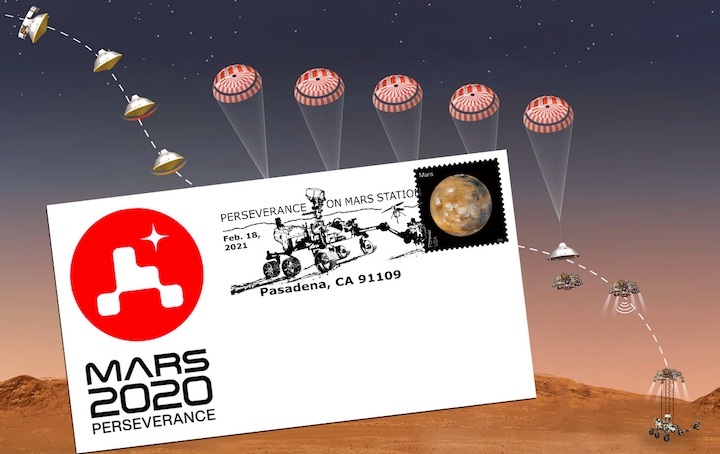
Mockup of a postmarked envelope for the Feb. 18, 2021 landing of NASA's Perseverance rover on Mars. The U.S. Postal Service is ready to produce the cancellation device and release the postmark once Perseverance touches down. (collectSPACE / NASA/JPL)
The U.S. Postal Service plans to mark NASA's next landing on Mars later this week, if indeed the agency's Perseverance rover makes it safely down to the surface of the Red Planet.
A special pictorial postmark has been designed to commemorate the touch down of the fifth U.S. wheeled robotic explorer on Mars. Perseverance is set to land in Jezero Crater on Thursday (Feb. 18), beginning NASA's first mission dedicated to searching for and caching signs of life for a future return to Earth.
The ink postmark will be applied by request to stamped envelopes, dating them for the Mars landing to create both a record of and a memento of the achievement.
That is, if the mission is successful.
Before the car-sized Perseverance can begin roving on the site of an ancient Martian river basin, it first must go through what mission engineers have described as the "seven minutes of terror." Not only is Jezero Crater considered the most challenging terrain targeted by a spacecraft for a landing on Mars, the rover must survive entry into the Martian atmosphere, deploy a parachute and dispose of its aeroshell, separate from its backshell and ignite thrusters, hover over the surface and then lower safely to the ground using a "sky crane."
And it has to do all of that under complete autonomous control, receiving no input from mission managers on Earth.
If Perseverance does survive, confirmation will come at or about 3:55 p.m. EDT (2055 GMT) on Thursday. Because of the distance that the signal has to travel from Mars to Earth, the actual landing on Mars will have taken place 11 minutes and 22 seconds before it is known to have succeeded here.
Upon learning that the rover is six-wheels down on the surface, the U.S. Postal Service (USPS) will proceed with manufacturing the commemorative cancellation device. If the landing does not go as planned and Perseverance is confirmed lost, then the USPS will not go forward with the pictorial postmark, per an agreement with NASA that dates back more than 20 years to the loss of another Mars lander.
The postmark, designed by artist Detlev van Ravenswaay of Bonn, Germany and coordinated by philatelist Stephen Stein, features the Perseverance rover and its experimental helicopter "Ingenuity" on the surface of Mars. The device is inscribed "Perseverance on Mars Station" and is dated "Feb. 18, 2021," with the location "Pasadena, CA 91109," the latter in reference to the post office nearest to NASA's Jet Propulsion Laboratory (JPL), from where the Mars mission is being managed.
Van Ravenswaay and Stein also coordinated with the USPS to prepare a pictorial postmark for the launch of Perseverance from Cape Canaveral Air Force Station (not Space Force Station) in Florida in July 2020.
Stamp and space memorabilia collectors often seek to have stamped envelopes postmarked at relevant post offices on dates associated with milestone events. These "covers," as they are called, document when and where history was made and serve as a memento of the occasion.
Collectors and members of the public desiring the Perseverance landing pictorial postmark can begin preparing now by affixing the proper postage in stamps on a self-addressed envelope (or addressed to others of their choice) and then placed into a larger envelope addressed to:
Perseverance on Mars Station
c/o Postmaster
600 Lincoln Avenue
Pasadena, California 91109-9998
The USPS recommends inserting a card of postcard thickness into the envelope to be postmarked for sturdiness and then tuck in the flap.
"Customers can also send stamped envelopes and postcards without addresses for postmark, as long as they supply a larger envelope with adequate postage and their return address. After applying the pictorial postmark, the Postal Service returns the items (with or without addresses) under addressed protective cover," the USPS instructs on its website.
Requests can be sent and an official notice will be published in the USPS's Postal Bulletin after NASA confirms Perseverance has successfully landed on Mars. The The USPS will honor requests for the pictorial postmark for (at least) 30 days after the touchdown.
The USPS is not the only organization marking the arrival of a spacecraft at Mars with a special ink stamp.
The United Arab Emirates (UAE) Government Media Office in collaboration with Dubai Airports recently announced that in celebration of the country's first interplanetary probe, "Hope," entering orbit around the Red Planet on Feb. 9, a special "Martian Ink" stamp will be applied to visitors' passports. The ink was made from the same type of volcanic basalt rocks that produces Mars' distinctive rusty color.
Quelle: CS
+++
Mars 2020 on track for landing

WASHINGTON — NASA’s Mars 2020 spacecraft is operating “perfectly” ahead of its Feb. 18 landing on Mars that will be a key milestone for the agency’s future Mars exploration plans.
The spacecraft is scheduled to land the rover Perseverance on the surface of Jezero Crater on Mars at about 3:55 p.m. Eastern Feb. 18. That time is when the signals from the spacecraft arrive on Earth based on a light travel time of 11 minutes and 22 seconds from Mars.
At a Feb. 16 briefing at the Jet Propulsion Laboratory, project officials said the spacecraft was on course and operating well ahead of its crucial entry, descent and landing (EDL) phase minutes before touchdown.
“Perseverance is operating perfectly right now, and all systems are go for landing,” Jennifer Trosper, deputy project manager for the mission, said at the briefing. Controllers sent on Feb. 12 the “DO EDL” command to the spacecraft, triggering a series of activities on the spacecraft to prepare for the landing.
While there is still the ability to adjust the spacecraft’s trajectory if needed, Trosper said that Mars 2020 is on track to land in Jezero Crater as planned. “The targeting is on the bull’s-eye, and we are headed exactly where we want to be for Mars,” she said.
Mars 2020 will use a landing system similar to that used by Curiosity, the rover that landed on Mars in 2012. That system does include some improvements, notably a technology called “terrain relative navigation” where the descending spacecraft takes images of the surface below and compares it to an onboard map, using that information to guide it to a safe landing zone.
Telemetry from Mars 2020 will be transmitted back to Earth during EDL through a “pseudo bent pipe” relay provided by the Mars Reconnaissance Orbiter spacecraft. That will provide the most data through landing, Trosper said, including the possibility of images from hazard cameras on the front and rear of the rover immediately after landing. The spacecraft will also transmit a series of tones directly to Earth in X-band during descent, providing information on key mission events.
Another orbiter, Mars Odyssey, will pass over Jezero Crater about three and a half hours after landing that will provide information on the status of the rover. “Getting that pass would give us a lot of information about the state of the vehicle,” she said. The European Space Agency’s ExoMars Trace Gas Orbiter will fly over the landing site a few hours after Odyssey, also with the ability to relay data from Perseverance.
“If all goes well, we could potentially see some images by the end of the day,” she said. “If not, it’s possible that something happened that maybe caused the vehicle to go into a safing mode after landing.” In that event, it could take several days to correct the issue and restore normal operations.
Perseverance itself is superficially similar to Curiosity, but with a new set of instruments and other upgrades, such as wheels that are strengthened after those on Curiosity were damaged by sharp rocks on the Martian surface. “Percy’s got a new set of kicks and she is ready for trouble on this Martian surface,” said Adam Steltzner, chief engineer for Perseverance.
Scientists will use the instruments on Perseverance to study the planet’s past habitability, including any evidence of ancient microbial life there. A major aspect of the mission, though, is to collect rock samples for later return to Earth as part of the overall Mars Sample Return program.
Mars Sample Return, which includes two missions launching no earlier than 2026 in cooperation with ESA to collect the samples cached by Perseverance and return them to Earth, accounts for the nearly all of NASA’s Mars exploration activities in the coming decade, beyond operation of existing missions. A failed landing by Perseverance would upend that strategy.
“It’s not adding stress,” Thomas Zurbuchen, NASA associate administrator for science, said of the implications of the Mars 2020 landing on Mars Sample Return. “We’re entirely focused on one thing right now, which is the successful landing.”
Trosper said Mars 2020 is the fifth Mars landing she’s been involved with. “The team has been doing a great job. The spacecraft is solid,” she said. “There are no guarantees, but I’m feeling great.”
In 2012, NASA famously called the EDL phase of the Curiosity mission the “seven minutes of terror,” referring to the time from when the spacecraft encounters the Martian atmosphere to when it lands, and all the hazards during that time that could doom the spacecraft. The agency is once again using the “seven minutes of terror” phase for the Perseverance landing, even though some involved with the mission think “terror” is perhaps a bit overwrought.
“Probably ‘terror’ is not the right word,” said Rob Manning, chief engineer at JPL and a veteran of past Mars landings, during a session of the Planetfest ’21 conference held by The Planetary Society Feb. 14. “It’s probably more like anxiety: deep, deep, deep anxiety.”
“When you see us cheer” after a successful landing, he added, “it’s not happiness. It’s relief, deep relief.”
Quelle: SN
+++
NASA’s Next Mars Rover Is Ready for the Most Precise Landing Yet
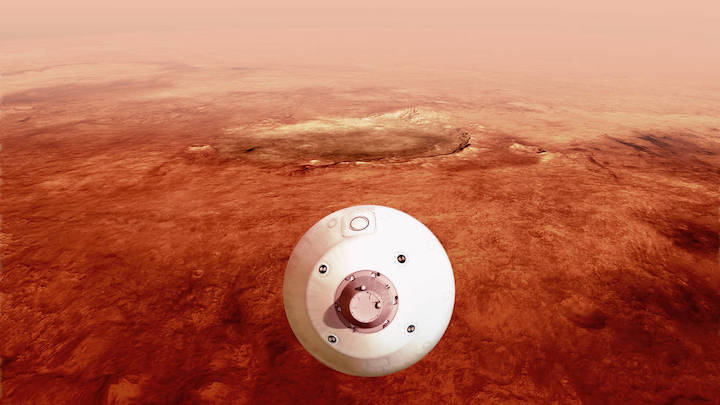
What to expect when the Mars 2020 Perseverance rover arrives at the Red Planet on Feb. 18, 2021.
With about 2.4 million miles (3.9 million kilometers) left to travel in space, NASA’s Mars 2020 Perseverance mission is days away from attempting to land the agency’s fifth rover on the Red Planet. Engineers at NASA’s Jet Propulsion Laboratory in Southern California, where the mission is managed, have confirmed that the spacecraft is healthy and on target to touch down in Jezero Crater at around 3:55 p.m. EST (12:55 p.m. PST) on Feb. 18, 2021.
“Perseverance is NASA’s most ambitious Mars rover mission yet, focused scientifically on finding out whether there was ever any life on Mars in the past,” said Thomas Zurbuchen, associate administrator for the Science Mission Directorate at NASA Headquarters in Washington. “To answer this question, the landing team will have its hands full getting us to Jezero Crater – the most challenging Martian terrain ever targeted for a landing.”
Jezero is a basin where scientists believe an ancient river flowed into a lake and deposited sediments in a fan shape known as a delta. Scientists think the environment here was likely to have preserved signs of any life that gained a foothold billions of years ago – but Jezero also has steep cliffs, sand dunes, and boulder fields. Landing on Mars is difficult – only about 50% of all previous Mars landing attempts have succeeded – and these geological features make it even more so. The Perseverance team is building on lessons from previous touchdowns and employing new technologies that enable the spacecraft to target its landing site more accurately and avoid hazards autonomously.
“The Perseverance team is putting the final touches on the complex choreography required to land in Jezero Crater,” said Jennifer Trosper, deputy project manager for the mission at JPL. “No Mars landing is guaranteed, but we have been preparing a decade to put this rover’s wheels down on the surface of Mars and get to work.”
You will get to watch the drama of Perseverance’s entry, descent, and landing (EDL) – the riskiest portion of the rover’s mission that some engineers call the “seven minutes of terror” – live on NASA TV. Commentary starts at 2:15 p.m. EST (11:15 a.m. PST) on Feb. 18. Engineers expect to receive notice of key milestones for landing at the estimated times below. (Because of the distance the signals have to travel from Mars to Earth, these events actually take place on Mars 11 minutes, 22 seconds earlier than what is noted here.)
– Cruise stage separation: The part of the spacecraft that has been flying Perseverance – with NASA’s Ingenuity Mars Helicopter attached to its belly – through space for the last six-and-a-half months will separate from the entry capsule at about 3:38 p.m. EST (12:38 p.m. PST).
– Atmospheric entry: The spacecraft is expected to hit the top of the Martian atmosphere traveling at about 12,100 mph (19,500 kph) at 3:48 p.m. EST (12:48 p.m. PST).
– Peak heating: Friction from the atmosphere will heat up the bottom of the spacecraft to temperatures as high as about 2,370 degrees Fahrenheit (about 1,300 degrees Celsius) at 3:49 p.m. EST (12:49 p.m. PST).
– Parachute deployment: The spacecraft will deploy its parachute at supersonic speed at around 3:52 p.m. EST (12:52 p.m. PST). The exact deployment time is based on the new Range Trigger technology, which improves the precision of the spacecraft’s ability to hit a landing target.
– Heat shield separation: The protective bottom of the entry capsule will detach about 20 seconds after the parachute deployment. This allows the rover to use a radar to determine how far it is from the ground and employ its Terrain-Relative Navigation technology to find a safe landing site.
– Back shell separation: The back half of the entry capsule that is fastened to the parachute will separate from the rover and its “jetpack” (known as the descent stage) at 3:54 p.m. EST (12:54 p.m. PST). The jetpack will use retrorockets to slow down and fly to the landing site.
– Touchdown: The spacecraft’s descent stage, using the sky crane maneuver, will lower the rover down to the surface on nylon tethers. The rover is expected to touch down on the surface of Mars at human walking speed (about 1.7 mph, or 2.7 kph) at around 3:55 p.m. EST (12:55 p.m. PST).
A variety of factors can affect the precise timing of the milestones listed above, including properties of the Martian atmosphere that are hard to predict until the spacecraft actually flies through.
Mission controllers also may not be able to confirm these milestones at the times listed above because of the complexity of deep-space communications. The flow of detailed engineering data (called telemetry) in near-real-time relies on a new kind of relay capability added this past year to NASA’s Mars Reconnaissance Orbiter (MRO). Engineers expect additional data to return to Earth directly through NASA’s Deep Space Network and two other Earth-based antennas until shortly before touchdown.
It’s important to note that the rover can land safely on Mars without communications with Earth: Perseverance has pre-programmed landing instructions and significant autonomy. Additional communication passes are planned in the hours and days following the landing event.
Once on the surface, one of Perseverance’s first activities will be to take pictures of its new home and transmit them back to Earth. Over the following days, engineers will also check on the health of the rover and deploy the remote sensing mast (otherwise known as its “head”) so it can take more pictures. The Perseverance team will then take more than a month to thoroughly inspect the rover and load new flight software to prepare for its search for ancient life on Mars. During the same period, the Ingenuity Mars Helicopter team will be making sure their small but mighty robot is prepared for the first attempt at controlled, powered aerodynamic flight on another planet.
“The Ingenuity team will be on the edge of our seats with the Perseverance team on landing day,” said MiMi Aung, the Ingenuity project manager at JPL. “We can’t wait until the rover and the helicopter are both safely on the surface of Mars and ready for action.”
More About the Perseverance Mission
A key objective of Perseverance’s mission on Mars is astrobiology, including the search for signs of ancient microbial life. The rover will characterize the planet’s geology and past climate, pave the way for human exploration of the Red Planet, and will be the first mission to collect and cache Martian rock and sediment for later return to Earth.
Subsequent NASA missions, in cooperation with ESA (European Space Agency), would send spacecraft to Mars to collect these sealed samples from the surface and return them to Earth for in-depth analysis.
The Mars 2020 mission is part of a larger NASA initiative that includes missions to the Moon as a way to prepare for human exploration of the Red Planet. NASA will establish a sustained human presence on and around the Moon through NASA’s Artemis lunar exploration plans.
JPL, a division of Caltech in Pasadena, California, manages the Mars 2020 Perseverance mission and the Ingenuity Mars Helicopter technology demonstration for NASA.
Quelle: NASA
+++
NASA Live
NEXT LIVE EVENTS
Feb. 17, Wednesday
12:30 p.m.—Countdown to Mars Perseverance Rover landing livestream Q&A for elementary school students
1 p.m.—Perseverance Mars Rover Mission Landing Update
3 p.m.—Perseverance Mars Rover briefing: "Searching for Ancient Life at Mars and in Samples Returned to Earth"
Feb. 18, Thursday
12:30 p.m.—Perseverance Mars Rover landing day livestream for all students
2:15 p.m.—NASA will provide multiple feeds of live landing coverage of the Perseverance Mars Rover, leading up to the rover's landing at approximately 3:55 p.m. EST.
- NASA TV coverage, with mission commentary, will be available on this page
- A "clean" feed of views inside mission control and mission audio only, will be available on NASA TV's media channel and the JPLraw YouTube Channel
- A 360-degree view inside mission control will be available on JPL's YouTube channel
2:30 p.m.—"Juntos Perseveramos": live Spanish-language landing commentary on NASA en Español’s YouTube channel.
5:30 p.m. (no earlier than)—Perseverance Mars Rover post-landing coverage
Quelle: NASA
+++
Perseverance Rover's Landing Site: Jezero Crater

NASA chose Jezero Crater as the landing site for the Perseverance rover. Scientists believe the area was once flooded with water and was home to an ancient river delta. The process of landing site selection involved a combination of mission team members and scientists from around the world, who carefully examined more than 60 candidate locations on the Red Planet. After the exhaustive five-year study of potential sites, each with its own unique characteristics and appeal, Jezero rose to the top.
Jezero Crater tells a story of the on-again, off-again nature of the wet past of Mars. More than 3.5 billion years ago, river channels spilled over the crater wall and created a lake. Scientists see evidence that water carried clay minerals from the surrounding area into the crater lake. Conceivably, microbial life could have lived in Jezero during one or more of these wet times. If so, signs of their remains might be found in lakebed or shoreline sediments. Scientists will study how the region formed and evolved, seek signs of past life, and collect samples of Mars rock and soil that might preserve these signs.
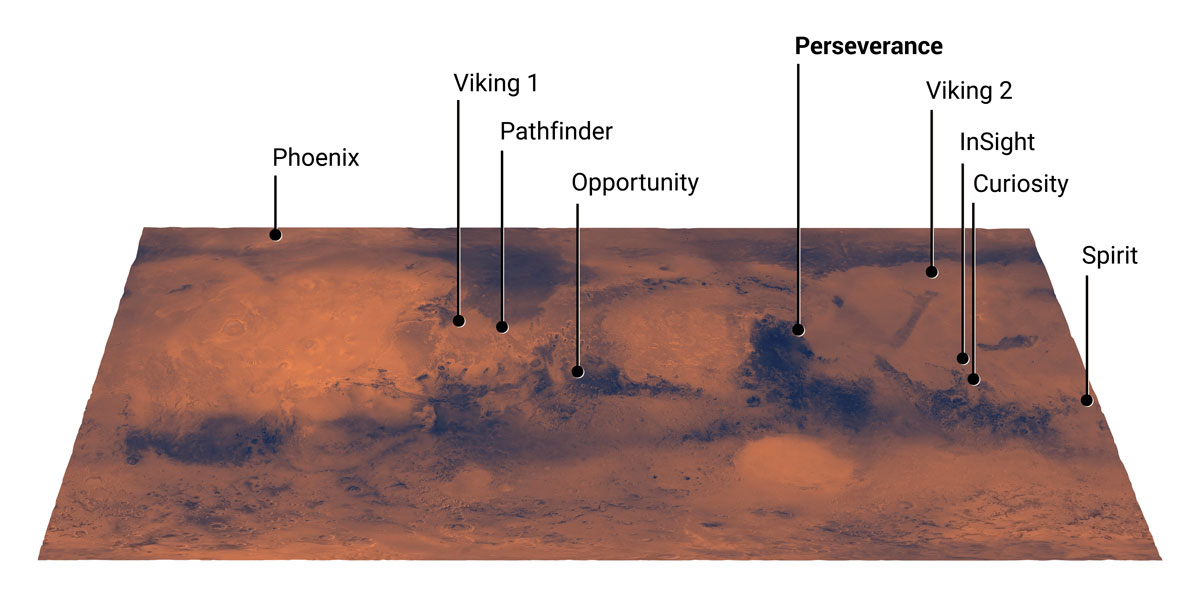
Jezero Crater
Jezero Crater is 28 miles (45 kilometers) wide, and is located on the western edge of a flat plain called Isidis Planitia, which lies just north of the Martian equator. The landing site is about 2,300 miles (3,700 kilometers) from Curiosity’s landing site in Gale Crater.
- Location:North of the Martian equator, in the Isidis Planitia region (18.4 degrees north / 77.5 degrees east)
- Diameter:28 miles (45 kilometers)
Take a Tour of Jezero Crater
Fly over Jezero Crater on a guided tour with Mars 2020 Project Scientist Ken Farley.
Jezero's Window to the Past
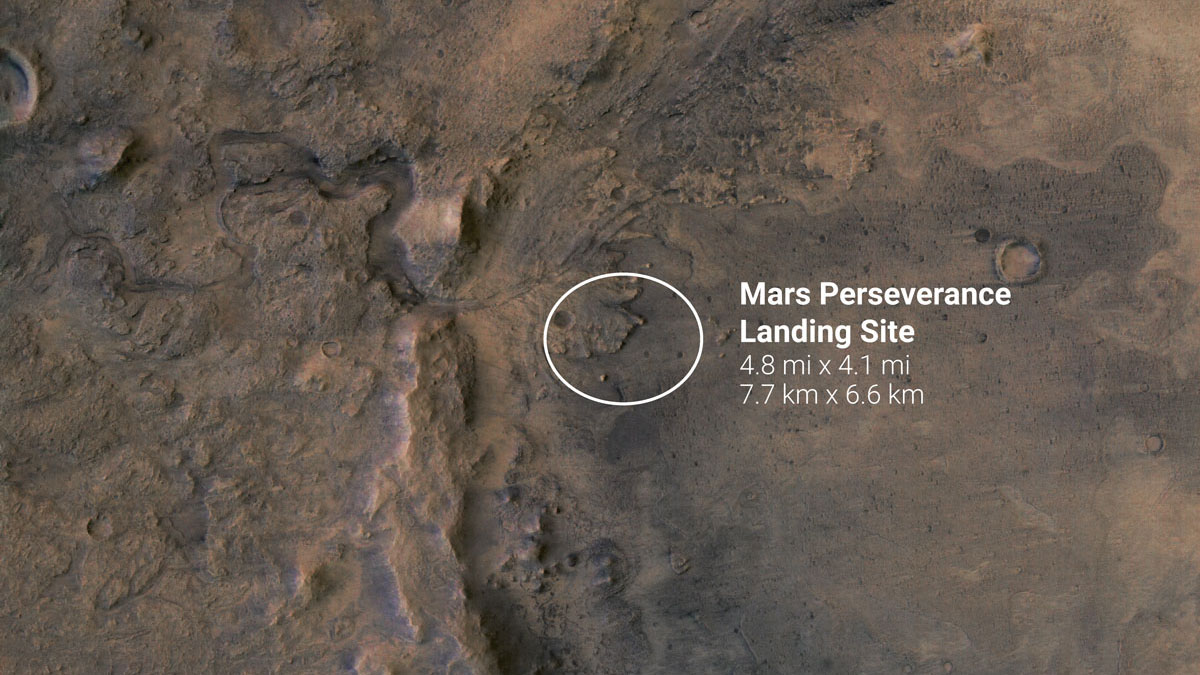
Jezero Crater sits within the Isidis Planitia region of Mars, where an ancient meteorite impact left behind a large crater some 750 miles (1,200 kilometers) across. This event is known as Isidis impact, and it forever changed the rock at the base of the crater. A later, smaller meteorite impact created the Jezero Crater within the Isidis impact basin. Scientists believe that these events likely created environments friendly to life. There is evidence of ancient river flow into Jezero, forming a delta that has long since been dry.
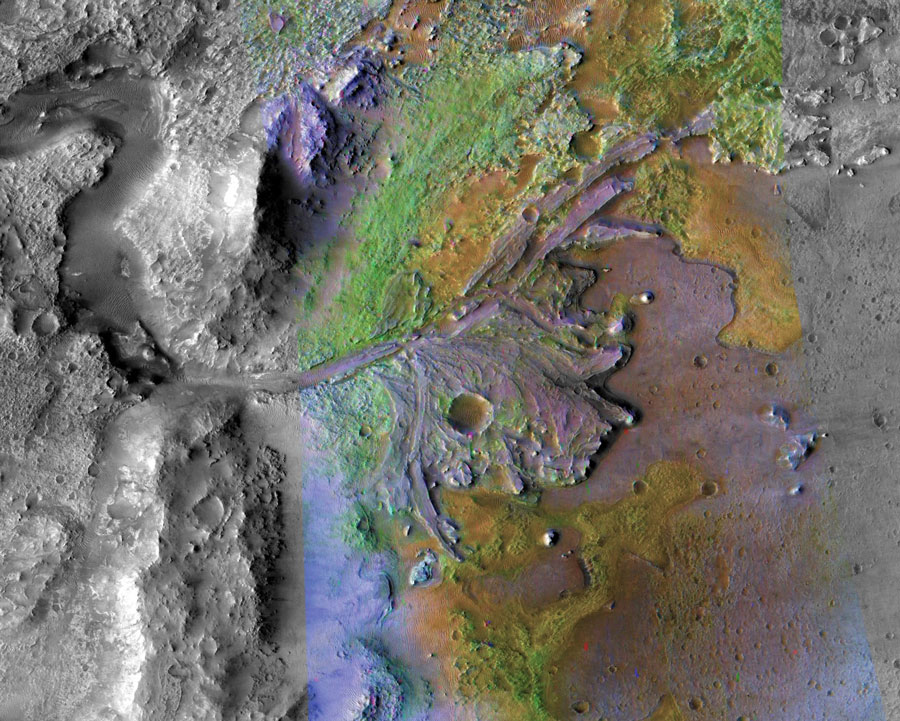
Jezero Crater is thus likely to have been habitable in the distant past. The Mars Reconnaissance Orbiter's CRISM instrument has revealed that the crater contains clays, which only form in the presence of water. On Earth, scientists have found such clays in the Mississippi river delta, where microbial life has been found embedded in the rock itself. This makes Jezero Crater a great place to fulfill the Mars 2020 mission's science goal of studying a potentially habitable environment that may still preserve signs of past life.
At Jezero Crater, Perseverance should be able to access rocks that are as old as 3.6 billion years. There are many ideas about what early Mars was like, and how it came to be what it is today. Accessing the ancient rock at Jezero should help answer some of these questions, and tell us more about the formation of rocky planets. It is also a great location for the rover to collect a variety of samples of Martian rock and soil.
The Name Game at Jezero Crater
Naming things is a great way to remember them. As Perseverance explores the Martian surface, the science team will assign unofficial names to especially interesting regions, features, and samples. This naming system is similar to the one used to name the Mars locations that the Curiosity rover has explored on Mars.
For Perseverance, the team has divided up the entire landing site, Jezero Crater, into squares. Each square will be matched to national parks and preserves on Earth with similar geology. As a nod to the diversity of the international science team, the plan is to find matching sites in countries that have contributed to the mission. As the rover explores Jezero Crater, any time the team sees an interesting feature, they will name it for a corresponding location here on Earth.
Within an area or region, individual features and rock targets will be named for locations within the Earthbound region for which it is named. For example, when the Curiosity team named one of its sites “Yellowknife Bay” after a location in Canada, individual rocks and targets within that area were named after features in Canada’s Yellowknife Bay.
Quelle: NASA
----
Update: 18.02.2021 / 17.45 MEZ
.
NASA Mars Perseverance Rover Update
Perseverance Will Land on Mars Today
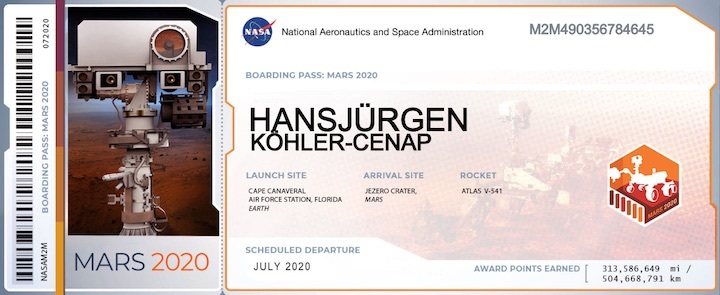

Perseverance Will Land on Mars Today
NASA’s Mars 2020 Perseverance rover, with the Ingenuity Mars Helicopter attached to its belly, is on target to touch down gently on the Red Planet around 3:55 p.m. EST (12:55 p.m. PST) today, Feb. 18, 2021.
The entry, descent, and landing team started on console at mission control at NASA’s Jet Propulsion Laboratory at 8:30 a.m. EST (5:30 a.m. PST) this morning. They are preparing for the spacecraft to start blazing through the Martian atmosphere at around 3:48 p.m. EST (12:48 p.m. PST). At the time of landing, Mars will be 127 million miles (204 million kilometers) from Earth. At this distance, the one-way light time – the amount of time for a signal to get from Perseverance to Earth – is 11 minutes, 22 seconds.

+++

Quelle: NASA
+++
Update: 20.45 MEZ
.





+++




+++
Update: 22.00 MEZ











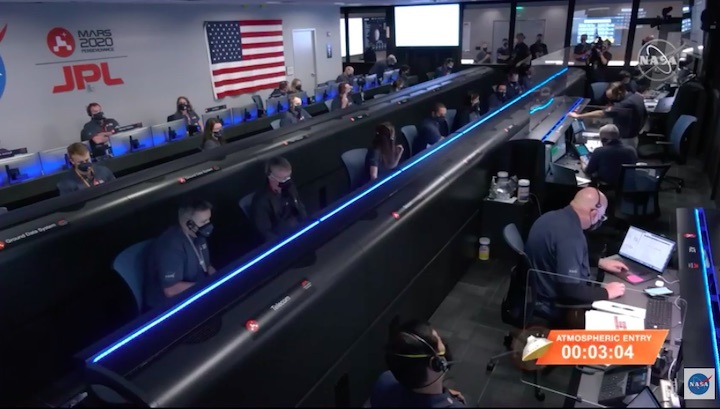



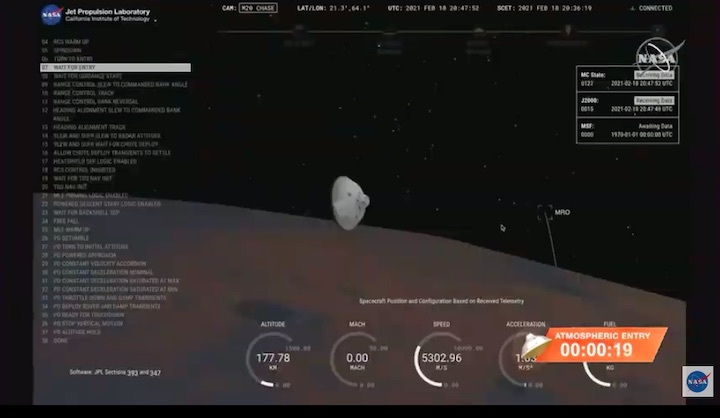
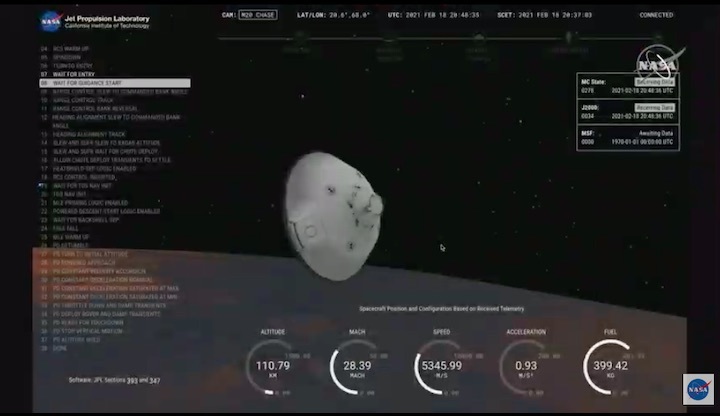

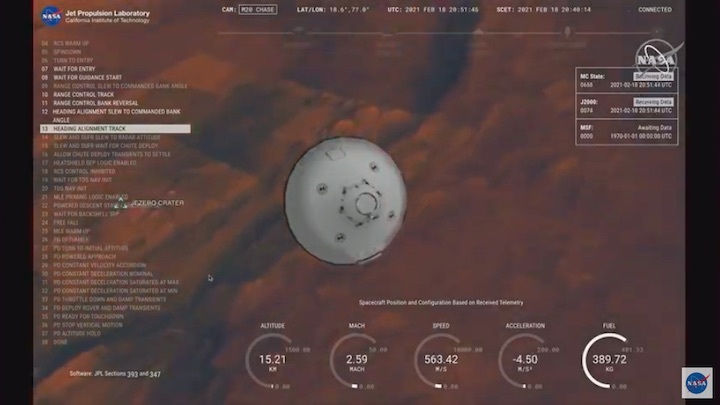




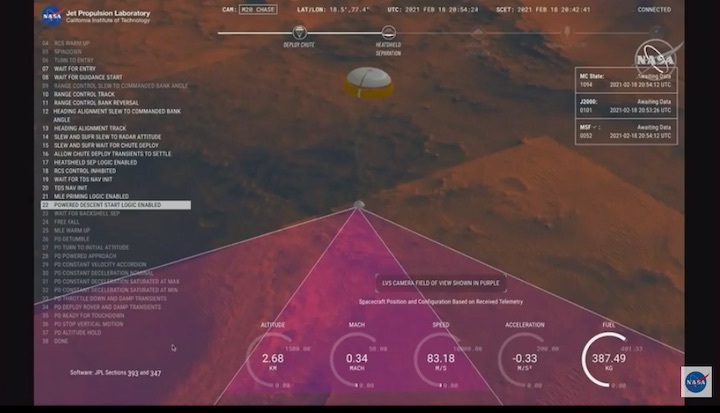

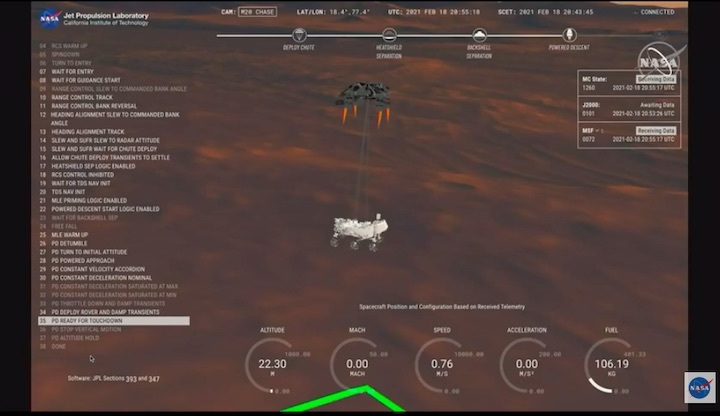






First Picture von Mars:



Quelle: NASA
+++





Quelle: NASA
